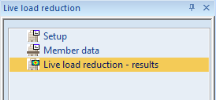LLR Results
LLR Parameters
Important LLR parameters, including tributary areas and influence areas and reduction factors, can be found within Live load reduction – results
| Term |
Definition or Abbreviation |
| Name |
Name of 1D member |
| Load Group |
Name of load group associated with results |
| Member Level |
Level of 1D member.
• Level 0 = Primary column members
• Level 1 = Primary beam (girder) members
• Level 2 = Secondary beam members
• Level 3 = Tertiary beam members
• etc…
|
| Local Tributary Area |
For a beam or girder, this is the floor area which, when loaded, will transfer load directly to the 1D member (i.e. load transfer occurs only through the 2D member; not through other 1D members).
For a column, this is the floor area which, when loaded, will transfer load to the column through beams and girders only on the floor which is directly supported by the column.
|
| Local Influence Area |
For a beam or girder, this is the floor area which, when loaded, has some non-negligible direct influence on structural effects of the 1D member (i.e. load transfer occurs only through the 2D member; not through other 1D members).
For a column, this is the floor area which, when loaded, has some non-negligible influence on structural effects of the column (load transfer through beams and girders only on the floor which is directly supported by the column).
|
| Tributary Area |
For a beam or girder, this is the total floor area which, when loaded, will transfer load to the 1D member. This includes load transfer through other 1D members.
For a column, this is the total floor area which, when loaded, will transfer load to the column through beams and girders (on all floors supported by the column).
|
| KLL |
Influence area / tributary area ratio |
| Influence Area |
For a beam or girder, this is the total floor area which, when loaded, has some non-negligible influence on structural effects of the 1D member. This includes load transfer through other 1D members.
For a column, this is the floor area which, when loaded, has some non-negligible influence on structural effects of the column (load transfer through beams and girders on all floors supported by the column).
|
| Reference Area |
This value is used in the calculation of the reduction factor for regular and roof live loads.
For regular loads, this is the area defined by the intersection of a member’s influence area and the member’s loaded area. I.e. It is the loaded influence area. For members which have evenly distributed surface load over the entire influence area, the reference area is equal to the influence area. For partially loaded members, the reference area is only the portion of the influence area which is loaded.
For roof loads, this is the area defined by the intersection of a member’s tributary area and the member’s loaded area. I.e. It is the loaded tributary area.
|
| Reduction Factor |
The reduction factor used for the 1D member. This value is calculated automatically or may be specified as member data. It is multiplied by the live load to attain a reduced live load.
When calculated automatically:
For regular and roof live loads, it is calculated from the reference area (loaded influence area for regular live loads and tributary area for roof live loads).
For heavy and parking garage live loads, it is equal to 0.8 for members supporting 2 or more floors.
|
Reduced Live Loads for Checks and Design
Reduced live loads can be used for checking and designing steel and composite members. They are available for strength (ULS) and serviceability (SLS) checks.
Once a load group has been designated for reduction, any load combination or result class containing a load case connected to the reduced load group can be used in the check. The live load and resulting internal force values used in the check will be reduced according to the reduction factor.

